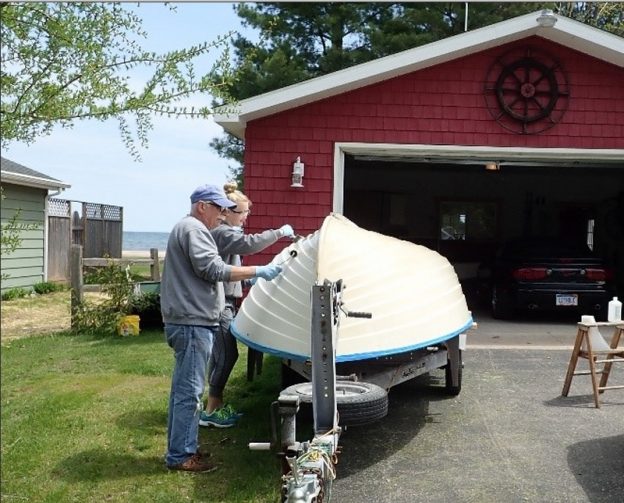

It will usually slough off in large portions. They will be worth every penny that you pay for them, at least!Īnyway, I have never seen fiberglass stay adhered to wood over a long period of time. Paul, here are a few more theories on fiberglass on wood boats. BTW, I'm presently replacing some planks on the bottom of my Chris. Talk about heavy I'd rather soak up a little water.and know my boat is closer to traditional construction. But it would need to be so thick it would be a fiberglass boat bottom with a wood topsides and deck. Then it would not flex and develop fine cracks. Unless one were to build up the thickness of the fiberglass so thick that it is stronger than the flexible wood hull construction. Ventilation is key to preventing the growth of wood rot. It gradually collects more water because there is not enough surface area for ventilation to occur. As it bends and flexes with the wood it will fail to be strong enough and will develop very tiny hairline cracks that will allow water to enter, ever so little at first.

The fiberglass layer is very brittle and is not nearly so flexible as the wood that it covers. The fiberglass layer will work for a short while. That can't be said for a fiberglassed bottom. What you end up with is a hull that is essentially identical construction to the factory bottom (that lasted a long long time) but with the advantages of a modern technology rubber membrane instead of the linseed soaked canvas that was between the bottom layers from the factory. The membrane effectively prevents water from getting past it to the inner ply and it follows the flexing of the boat as it charges through the waves and over boat wakes. When the boat is left in the water for an extended time (like all summer) the outer planks still absorb water just like they did when the boat was brand new thirty, forty, fifty years ago. The 5200 acts as a rubber membrane between the inner layer and the outer layer. I can't understand why he would say that other than CC boats have always been suggested to be stored on a lift or trailer so they don't incur weight-gain from water absorption, making them heavier and thus a lower top speed period. You made a comment that Danenberg recommends even with the 5200 all boats should be stored on a lift. The fiberglassed bottom is Mahogany Murder. I vote for the 5200 bottom, just as most others. It will be at least 6 to 10 months before I begin this project, so I plan to find out as many of the pros and cons of both these systems. What types of bottoms do you have on your boats? Original, redone (5200), somthing else? How long do your boats stay in the water? The determining factor is that I need an end result that can stay in the water without waterlog and wood movement concerns. The resulting base would have greater adhession to the glass/epoxy finish and no matter what the humidity, marine plywood is quite stable. As I mentioned yesterday, there is no reason that CPES can't be used on the plywood and frame, and 5200 used to bed the plywood to the frame. I do not know the method that Sierra Boat Company employs, but I am assuming that the planked bottom is stripped off and that a base plywood bottom is used for the fiber glass cloth and resin finish. The two of you have a collective boat experience that far surpasses anything I could expect to achieve and Wilson, might I add that the Brass Bell is a superb piece of work-now on to the subject. Of course there are exceptions.īill and Wilson, thank you for the posts, and might I add that I am honored to have you weigh in on the subject. Most boats that have been glassed will eventually rot from the inside out. Once things get more advanced, the glass can lose its adhesion then you have a mess. After months of this, year after year, the rot spores will grow and planks will become soft with rot. But from the inside, as the wood takes on moisture in more humid climates, or from wet swim suits, beach towels, skis, the dog, rain, spray, etc, much of that moisture makes its way to the bilge, or inner planks. The problem with glass is that effectively eliminates moisture infiltration from the outside.

You have to remember that in the Tahoe area, you are talking about a year-round climate that is incredibly dry.as in no humidity.ever. Sierra Boat is a good example of a reputable restorer successfully using glass over wood on their restorations.

If you want my long, windy dissertation on epoxy, I'll give my thoughts then we'll really open the floodgates.Īs for fiberglassing bottoms, I would have to agree that, generally speaking, it is not a good idea. I think both have their merits although most are siding with 5200 for various reasons. Paul, I am not necessarily a proponent of one system vs.


 0 kommentar(er)
0 kommentar(er)
